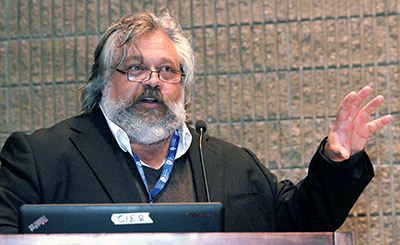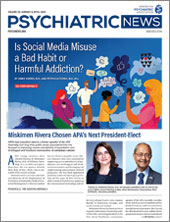NIDA Session Highlights Strategies for Deterring Opioid Abuse
Abstract
Research shows that up to 71 percent of people who are prescribed opioids fail to properly discard the drugs after discontinuing use, increasing the risk that the medications will be abused by others.
Opioid misuse is at epidemic proportions in the United States, with deaths due to opioid overdose quadrupling since 1999. At APA’s 2016 Annual Meeting last month, the National Institute on Drug Abuse (NIDA) sponsored a session on therapeutic developments that may one day help to reverse this public health crisis.

Thomas Jenkins, Ph.D., describes several pharmacological developments that may one day help to thwart the current opioid epidemic.
According to Thomas Jenkins, Ph.D., executive vice president and chief scientific officer at Elysium Pharmaceuticals, up to 71 percent of people who are prescribed opioids fail to properly discard the drugs after discontinuing use, increasing the risk that they will be used by other household members.
In an effort to reduce diversion, Elysium developed XpiRx (pronounced expire), a pill that consists of the opioid receptor agonist hydrocodone and the opioid antagonist naltrexone. According to Jenkins, human studies have found that combined opioid agonist and opioid antagonist therapies are less likely to be abused than opioid agonists alone; however, this particular investigational therapy goes a step further in deterring abuse.
“Opioid medications have a half-life of 70 years,” said Jenkins. According to results of studies with opioid-dependent animals presented by Jenkins, XpiRx loses its effectiveness at a faster rate than currently available opioid painkillers, with animals demonstrating reduced “drug liking” after six months; after one year, the medication was found to be ineffective.
Another abuse-deterrent medication by Elysium involves a version of an opioid agonist that becomes activated when it interacts with a specific protein in the intestines, reducing the potential for the drug to be misused by snorting or injection. The drug is in a phase 1 trial.
The session also highlighted monoclonal antibodies as a potential deterrent to initiating or continuing use of heroin.
Kim Janda, Ph.D., an immunologist and director of the Worm Institute for Research and Medicine at the Scripps Research Institute, presented data from two animal studies—one in primates and another in rodents—that examined the effectiveness of the technology coined the “heroin vaccine.” Results from the primate study showed that the antibody was effective in preventing heroin from crossing the blood-brain barrier, while results from the rodent trials showed that rats with heroin dependence that were given the vaccine were less likely to seek out the heroin and engage in compulsive heroin self-administration following abstinence.
“Vaccines are important and would be a great therapy [to thwart opioid abuse],” said Janda. “They require no continued daily compliance, have no significant chance of being used illicitly, and [have the potential] to reduce risk of overdose.” ■



